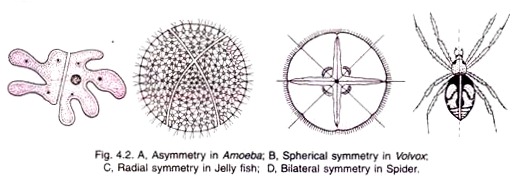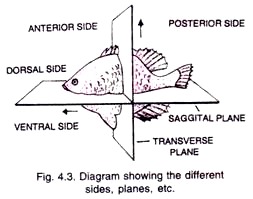The following points highlight the three types of symmetry in animals. The types are: 1. Spherical Symmetry 2. Radial Symmetry 3. Bilateral Symmetry.
Type # 1. Spherical Symmetry:
In this type of symmetry, the body of the individual can be divided into similar halves by any plane passing through the centre, e.g. Volvox, some sponges and some corals.
Type # 2. Radial Symmetry:
In this type of symmetry, the body of the individual divided into equal halves by any plane passing through the centre from top to bottom.
The type of symmetry is found in some sponges (Sycon), cnidarians (e.g. Hydra jelly), and echinoderms (e.g. star fish). When the body can be divided into two similar halves by one or two vertical planes only, the radial symmetry is called biradial symmetry. It is present in the sea anemones.
Type # 3. Bilateral Symmetry:
In this type of symmetry, the body can be divided into two equal halves by a single plane only because the important body organs are paired and occur on the two sides of a central axis. Bilateral symmetry is found in many invertebrates and all vertebrates.
i. The right and left sides of the body are called the lateral sides. The side of the body which is kept forward during locomotion is termed the anterior side and the opposite one is called posterior side. The back or upper surface is termed dorsal and the under surface (towards the substratum) is called ventral (Lventerbelly).
ii. The part of a tissue, organ, etc. that is nearest to the point of attachment or origin is known as proximal end. For example, upper arm is proximal end of the forelimb. The part of a tissue, organ, limb, etc. that is farther away from the point of attachment or origin is called distal end. For example, the fingers are at the distal end of the fore limb.
iii. Anatomical Body Planes.
Animal body can be cut along three planes (transverse, horizontal and vertical) for examining its internal structure. A vertical section passing through the middle line of the body is known as the saggital section.

